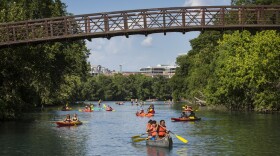Summer has come to Austin. Lately, that means the spread of toxic algae in greenbelts and waterways that can be dangerous for humans and fatal to dogs. To combat blue-green algae the city will again apply a special treatment to parts of Lady Bird Lake starting this week.
So far, the efforts have yielded mixed results.
This is the fourth year in a five-year pilot program to study the usefulness of the treatment. It is a kind of modified clay that sticks to phosphorus in the water and pulls it to the bottom of the lake.
The algae eats phosphorus, so with less phosphorus available, there should be less algae.
But, so far, the clay has not decreased algae levels in areas treated east of I-35.
The treatment seems to have been a bit more successful around Red Bud Isle, where it appears to have reduced algae growth early in the summer. But, city researchers report, the algae is persistent and still returns to the area each following year.
Beginning this week, contractors will be applying the treatment from a barge around Red Bud Isle, the boat ramp on the north shore of Lady Bird Lake, just west of I-35, and the north shore of the lake between I-35 and the lagoon behind the Festival Beach Boat Ramp.
According to a city press release, applying the treatment “will look like the team is spraying a gray slurry into the lake that temporarily clouds the water. The substance is safe, but recreational boaters should stay away from the barge.”
The algae have posed health risks for Austinites and poisoned several pet dogs since they showed up on the lake in 2019 after major floods injected high levels of plant nutrients into the water.
City scientists say fertilizer runoff from nearby lawns, upstream agriculture, along with septic waste all contribute to the growth of blue-green algae in the water.
Warming temperatures and drought also play a role.
Officials say people can help decrease algae levels in the lake by picking up animal waste and limiting the amount of fertilizer they use on lawns.
They caution people to not enter the water or allow their pets to if it is still, warm or if film or algae is visible in it.
While Lady Bird Lake is a popular spot for people to allow their dogs to cool off, humans are not allowed to swim there.





